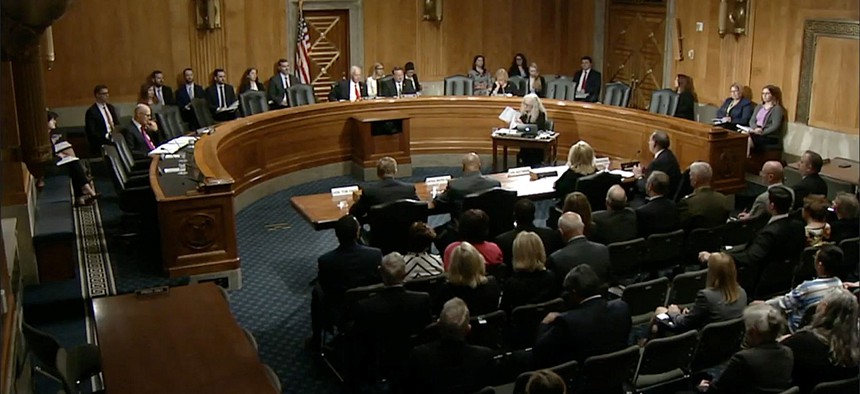OPM Nominee Defends Tenure at Labor Authority, Commits to Working with Lawmakers on GSA Merger
Dale Cabaniss dismissed her record-low employee morale scores at FLRA as backlash to efforts to make the agency “more fair” and effective.
At her Senate confirmation hearing Tuesday, Office of Personnel Management Director nominee Dale Cabaniss defended herself from criticism of her tenure as chairwoman of an agency tasked with resolving labor-management disputes, arguing low morale during her time there was the result of disgruntled employees.
Last month, Government Executive found that in 2007, the Federal Labor Relations Authority with Cabaniss at the reins ranked dead last among federal agencies, with an employee engagement score of 18.1, according to the Partnership for Public Service’s Best Places to Work in the Federal Government report. A former senior official at the agency described her tenure from 2001 until early 2008 as one marked by a “deficit of leadership,” and during those years, the backlog of cases pending before the board increased dramatically.
Sen. Gary Peters, D-Mich., ranking member of the Senate Homeland Security and Governmental Affairs Committee, asked Cabaniss about low morale at the FLRA while she was chairwoman. Cabaniss characterized the data as the result of employee backlash to her efforts to reform the agency.
“It was a time of change when I arrived; there were a lot of deficiencies in HR and procurement and acquisition issues, and employees were not treated equally,” Cabaniss said. “There were a lot of changes in policies and guidance, not only to be consistent with [President George W. Bush’s] management agenda, but to make sure everyone is treated fairly. I understand it was not popular, but they were things we needed to do to be stewards of taxpayer dollars and to make sure merit principles were followed.”
Cabaniss also said that developments outside of the FLRA at the time may have had a negative impact on employee morale.
“There were external forces that were seen as threats to the agency at the time,” she said. “The Department of Homeland Security was looking at whether or not collective bargaining was consistent with national security, and the Defense Department was considering a new [pay for performance] system. So at the same time as there were internal changes, there were threats to the agency that could have cost it 60 percent of its jurisdiction.”
Given the Trump administration’s proposal that effectively would dissolve OPM by sending its various functions to the Defense Department and the General Services Administration, Peters asked Cabaniss if she would do anything differently to preserve morale during a period of change.
“Any opportunity you have to be a leader and a manager, you’re constantly learning from the experience you have,” she said. “Change is a constant in our world today, and we’ve got to figure out a way to help employees manage their emotions around that change and provide as much information as possible. So we have to do what we can so that people feel like they have enough information to make an informed decision about what to do.”
Multiple senators pressed Cabaniss to commit to share all analysis done by OPM to justify the proposal to merge with GSA, including any cost-benefit analyses. They noted that committee members have sought information for more than a year about the proposal, particularly implementation plans, to no avail.
“The committee has been asking for basic information about these plans, from the cost of implementation to timelines and analysis of the expected impact on the workforce,” Peters said. “Will you, if confirmed, go through a thorough evaluation of the existing analysis of any reorganization efforts already underway [and report back to us]?”
The nominee replied: “As a private citizen, what I know [about the proposal] is based on the president’s management agenda and the [fiscal 2020] budget request. I’m not sure about using cost-benefit analyses as a term of art. When agencies came to us [when I was a Senate staffer] to restructure certain offices and do realignments, I don’t think I ever saw a cost-benefit analysis. But I agree absolutely from standing on the other side that you need all the information.”
Sen. Maggie Hassan, D-N.H., asked Cabaniss to clarify her position on the role of labor unions in the federal government, citing the Trump administration’s efforts to curtail unions’ influence on agency operations.
“The current administration is openly hostile to federal employees and unions, from bargaining in bad faith to using employees as pawns in a politically driven government shutdown,” Hassan said. “It’s the job of OPM director to advocate on behalf of the employees that serve the American people and make sure that they’re valued and respected. Do you believe it is in the best interest to allow collective bargaining and the other activities that flow from that?”
“Yes, the statute establishing the Federal Labor Relations Authority finds that collective bargaining is in the public interest,” Cabaniss said. “I will follow the statute.”
Cabaniss declined to take questions from reporters following the hearing.




